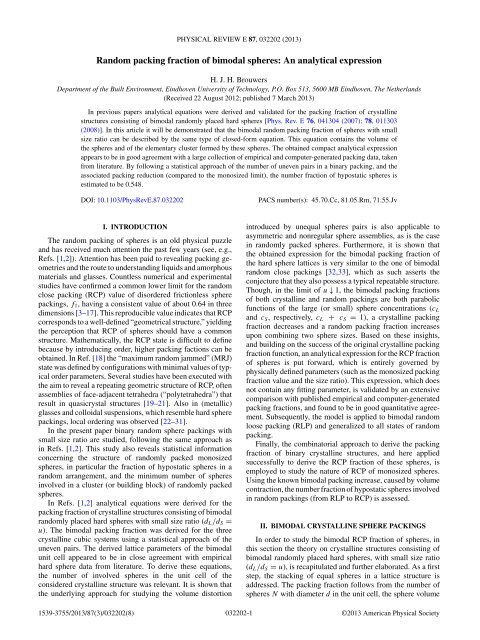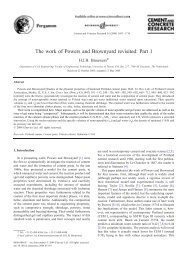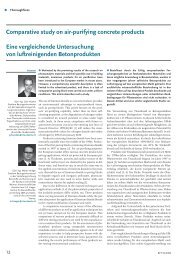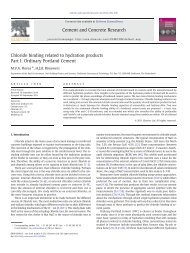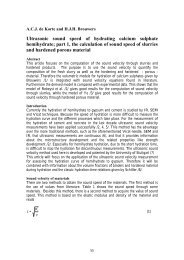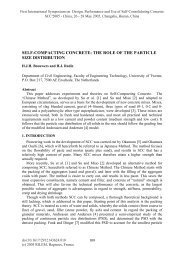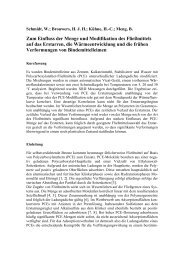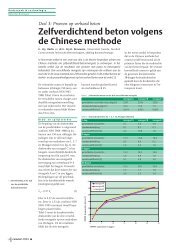Random packing fraction of bimodal spheres - American Physical ...
Random packing fraction of bimodal spheres - American Physical ...
Random packing fraction of bimodal spheres - American Physical ...
Create successful ePaper yourself
Turn your PDF publications into a flip-book with our unique Google optimized e-Paper software.
PHYSICAL REVIEW E 87, 032202 (2013)<strong>Random</strong> <strong>packing</strong> <strong>fraction</strong> <strong>of</strong> <strong>bimodal</strong> <strong>spheres</strong>: An analytical expressionH. J. H. BrouwersDepartment <strong>of</strong> the Built Environment, Eindhoven University <strong>of</strong> Technology, P.O. Box 513, 5600 MB Eindhoven, The Netherlands(Received 22 August 2012; published 7 March 2013)In previous papers analytical equations were derived and validated for the <strong>packing</strong> <strong>fraction</strong> <strong>of</strong> crystallinestructures consisting <strong>of</strong> <strong>bimodal</strong> randomly placed hard <strong>spheres</strong> [Phys.Rev.E76, 041304 (2007); 78, 011303(2008)]. In this article it will be demonstrated that the <strong>bimodal</strong> random <strong>packing</strong> <strong>fraction</strong> <strong>of</strong> <strong>spheres</strong> with smallsize ratio can be described by the same type <strong>of</strong> closed-form equation. This equation contains the volume <strong>of</strong>the <strong>spheres</strong> and <strong>of</strong> the elementary cluster formed by these <strong>spheres</strong>. The obtained compact analytical expressionappears to be in good agreement with a large collection <strong>of</strong> empirical and computer-generated <strong>packing</strong> data, takenfrom literature. By following a statistical approach <strong>of</strong> the number <strong>of</strong> uneven pairs in a binary <strong>packing</strong>, and theassociated <strong>packing</strong> reduction (compared to the monosized limit), the number <strong>fraction</strong> <strong>of</strong> hypostatic <strong>spheres</strong> isestimated to be 0.548.DOI: 10.1103/PhysRevE.87.032202PACS number(s): 45.70.Cc, 81.05.Rm, 71.55.JvI. INTRODUCTIONThe random <strong>packing</strong> <strong>of</strong> <strong>spheres</strong> is an old physical puzzleand has received much attention the past few years (see, e.g.,Refs. [1,2]). Attention has been paid to revealing <strong>packing</strong> geometriesand the route to understanding liquids and amorphousmaterials and glasses. Countless numerical and experimentalstudies have confirmed a common lower limit for the randomclose <strong>packing</strong> (RCP) value <strong>of</strong> disordered frictionless sphere<strong>packing</strong>s, f 1 , having a consistent value <strong>of</strong> about 0.64 in threedimensions [3–17]. This reproducible value indicates that RCPcorresponds to a well-defined “geometrical structure,” yieldingthe perception that RCP <strong>of</strong> <strong>spheres</strong> should have a commonstructure. Mathematically, the RCP state is difficult to definebecause by introducing order, higher <strong>packing</strong> factions can beobtained. In Ref. [18] the “maximum random jammed” (MRJ)state was defined by configurations with minimal values <strong>of</strong> typicalorder parameters. Several studies have been executed withthe aim to reveal a repeating geometric structure <strong>of</strong> RCP, <strong>of</strong>tenassemblies <strong>of</strong> face-adjacent tetrahedra (“polytetrahedra”) thatresult in quasicrystal structures [19–21]. Also in (metallic)glasses and colloidal suspensions, which resemble hard sphere<strong>packing</strong>s, local ordering was observed [22–31].In the present paper binary random sphere <strong>packing</strong>s withsmall size ratio are studied, following the same approach asin Refs. [1,2]. This study also reveals statistical informationconcerning the structure <strong>of</strong> randomly packed monosized<strong>spheres</strong>, in particular the <strong>fraction</strong> <strong>of</strong> hypostatic <strong>spheres</strong> in arandom arrangement, and the minimum number <strong>of</strong> <strong>spheres</strong>involved in a cluster (or building block) <strong>of</strong> randomly packed<strong>spheres</strong>.In Refs. [1,2] analytical equations were derived for the<strong>packing</strong> <strong>fraction</strong> <strong>of</strong> crystalline structures consisting <strong>of</strong> <strong>bimodal</strong>randomly placed hard <strong>spheres</strong> with small size ratio (d L /d S =u). The <strong>bimodal</strong> <strong>packing</strong> <strong>fraction</strong> was derived for the threecrystalline cubic systems using a statistical approach <strong>of</strong> theuneven pairs. The derived lattice parameters <strong>of</strong> the <strong>bimodal</strong>unit cell appeared to be in close agreement with empiricalhard sphere data from literature. To derive these equations,the number <strong>of</strong> involved <strong>spheres</strong> in the unit cell <strong>of</strong> theconsidered crystalline structure was relevant. It is shown thatthe underlying approach for studying the volume distortionintroduced by unequal <strong>spheres</strong> pairs is also applicable toasymmetric and nonregular sphere assemblies, as is the casein randomly packed <strong>spheres</strong>. Furthermore, it is shown thatthe obtained expression for the <strong>bimodal</strong> <strong>packing</strong> <strong>fraction</strong> <strong>of</strong>the hard sphere lattices is very similar to the one <strong>of</strong> <strong>bimodal</strong>random close <strong>packing</strong>s [32,33], which as such asserts theconjecture that they also possess a typical repeatable structure.Though, in the limit <strong>of</strong> u ↓ 1, the <strong>bimodal</strong> <strong>packing</strong> <strong>fraction</strong>s<strong>of</strong> both crystalline and random <strong>packing</strong>s are both parabolicfunctions <strong>of</strong> the large (or small) sphere concentrations (c Land c S , respectively, c L + c S = 1), a crystalline <strong>packing</strong><strong>fraction</strong> decreases and a random <strong>packing</strong> <strong>fraction</strong> increasesupon combining two sphere sizes. Based on these insights,and building on the success <strong>of</strong> the original crystalline <strong>packing</strong><strong>fraction</strong> function, an analytical expression for the RCP <strong>fraction</strong><strong>of</strong> <strong>spheres</strong> is put forward, which is entirely governed byphysically defined parameters (such as the monosized <strong>packing</strong><strong>fraction</strong> value and the size ratio). This expression, which doesnot contain any fitting parameter, is validated by an extensivecomparison with published empirical and computer-generated<strong>packing</strong> <strong>fraction</strong>s, and found to be in good quantitative agreement.Subsequently, the model is applied to <strong>bimodal</strong> randomloose <strong>packing</strong> (RLP) and generalized to all states <strong>of</strong> random<strong>packing</strong>.Finally, the combinatorial approach to derive the <strong>packing</strong><strong>fraction</strong> <strong>of</strong> binary crystalline structures, and here appliedsuccessfully to derive the RCP <strong>fraction</strong> <strong>of</strong> these <strong>spheres</strong>, isemployed to study the nature <strong>of</strong> RCP <strong>of</strong> monosized <strong>spheres</strong>.Using the known <strong>bimodal</strong> <strong>packing</strong> increase, caused by volumecontraction, the number <strong>fraction</strong> <strong>of</strong> hypostatic <strong>spheres</strong> involvedin random <strong>packing</strong>s (from RLP to RCP) is assessed.II. BIMODAL CRYSTALLINE SPHERE PACKINGSIn order to study the <strong>bimodal</strong> RCP <strong>fraction</strong> <strong>of</strong> <strong>spheres</strong>, inthis section the theory on crystalline structures consisting <strong>of</strong><strong>bimodal</strong> randomly placed hard <strong>spheres</strong>, with small size ratio(d L /d S = u), is recapitulated and further elaborated. As a firststep, the stacking <strong>of</strong> equal <strong>spheres</strong> in a lattice structure isaddressed. The <strong>packing</strong> <strong>fraction</strong> follows from the number <strong>of</strong><strong>spheres</strong> N with diameter d in the unit cell, the sphere volume1539-3755/2013/87(3)/032202(8) 032202-1©2013 <strong>American</strong> <strong>Physical</strong> Society
H. J. H. BROUWERS PHYSICAL REVIEW E 87, 032202 (2013), and the unit cell volume V cell :f cp1 = N = N π 6 d3, (1)V cell l 3with l as lattice constant or lattice parameter [1,2]. Forexample, for the fcc structure holds N = 4 and l = 2 1/2 d,for the bcc structure N = 2 and l = 2d/3 1/2 , and for thesc structure holds N = 1 and l = d, yielding as monosized<strong>packing</strong> <strong>fraction</strong>s f1 fcc = 2 1/2 π/6, f1 bcc = 3 1/2 π/8, and f1 sc =π/6, respectively.For an arrangement <strong>of</strong> <strong>bimodal</strong> <strong>spheres</strong>, the mean spherevolume readily follows as = X L L + X S S = X L L + (1 − X L ) S= π[ X L dL 3 + (1 − X ]L)dS3 , (2)6with X as the number <strong>fraction</strong> and the subscripts S and Lreferring to small and large <strong>spheres</strong>, respectively. The cellvolume, using the statistically probable combinations <strong>of</strong> smalland large <strong>spheres</strong> [1,2], followed asn∑{( )nVcell =Xi n−iL(1 − X L) ii=0[ n − i×nl3 L + i n l3 S + λ (i l3L − l 3 ) ]}S , (3)with n the number <strong>of</strong> <strong>spheres</strong> that form the elementary buildingblock <strong>of</strong> the crystal structure considered. In Eq. (3), the latticedistortion is accounted for by the factor λ i , which allows forthe spacing resulting from the combination <strong>of</strong> the large andsmall <strong>spheres</strong> in the cells in which they both appear (1 i n − 1). Their size ratio u is small, so that it can be assumedthat the large-scale structure <strong>of</strong> the system is not changedas u varies, and it is supposed that the volume distortionis a linear function <strong>of</strong> the volume mismatch. The distortionindeed tends to zero when l 3 S tends to l3 L, that is, when amonosized system is obtained and V cell should tend to l 3 S =l 3 L . The distortion parameter λ i is furthermore proportionalto the number <strong>of</strong> distorted contacts (b LS ) divided by the totalnumber <strong>of</strong> contacts (b t ) <strong>of</strong> the unit cell [2]. Uneven pairs <strong>of</strong><strong>spheres</strong> are considered as distorted contacts. A combinatorialcomputation <strong>of</strong> the possible <strong>bimodal</strong> configurations for the fcc,bcc, and sc lattices showed that in general terms λ i readsλ i = C b LS(i)2b t= C( n − 2)i − 1( n)ii(n − i)= C (1 i n − 1), (4)n(n − 1)where C is a proportionality constant, which value followsfrom a boundary condition (as seen below). The naturalquestion is whether Eq. (4) holds for every unit cell consisting<strong>of</strong> two types <strong>of</strong> <strong>spheres</strong> and sphere pairs. This question isanswered affirmatively by a rigorous mathematical pro<strong>of</strong> basedon basal combinatorial and probabilistic counting arguments[34,35], which is recapitulated here.Assume we have a contact network involving n <strong>spheres</strong>,<strong>of</strong> which i <strong>spheres</strong> are small. Choose one arbitrary contactinvolving <strong>spheres</strong> (really, vertices in a network) u and v. Thetotal number <strong>of</strong> choices <strong>of</strong> <strong>spheres</strong> for u and v is n(n − 1) byinspection, whereas for a distorted contact we can choose eitheru to be small (i choices) and v to be large (n − i choices), orvice versa, resulting in 2i(n − i) possibilities. This gives usb LS (i)/b t = 2i(n − i)/[n(n − 1)], independent <strong>of</strong> the choicefor u and v, and yielding Eq. (4).Surprisingly, this pro<strong>of</strong> shows that the distortion dependsonly on the number <strong>of</strong> <strong>spheres</strong> and pairs <strong>of</strong> the sphere cluster,but not on the way the contacts are distributed among the<strong>spheres</strong> in this cluster. To summarize, by counting the possibleuneven pairs to b LS in an alternative way [34,35]itisaffirmedthat Eq. (4) is actually a generic formula for all clusters (andunit cells) that consist <strong>of</strong> two types <strong>of</strong> <strong>spheres</strong>. Inserting Eq. (4)in Eq. (3) yieldsV cell = X L l 3 L + (1 − X L)l 3 S + CX L(1 − X L ) ( l 3 L − l3 S). (5)Equation (5) is also applicable when the thermodynamic limitis taken, with i and n going to infinity and i/n = constant.This is a different interpretation to the case where n is takento be a small constant which is the smallest identifiable clustersize or unit cell size. In Refs. [1,2] the smallest building block<strong>of</strong> sc, bcc, and fcc lattices were identified, in order to be ableto analyze all possible configurations, their probabilities, andtheir contribution to the distortion. The disadvantage <strong>of</strong> thisapproach was that it involved a lot <strong>of</strong> computations and thatone needs to do a separate careful analysis for every differentbuilding block. From the generic solution presented here, thislimitation is not needed anymore, so sphere arrangementscomprising multiples <strong>of</strong> n and N would yield the sameconclusion and equations [Eqs. (4) and (5)]. Furthermore,it appears that both equations are valid not only for regular(crystalline) structures as examined in Refs. [1,2], but als<strong>of</strong>or irregular (random) structures where the number <strong>of</strong> <strong>spheres</strong>may be infinite, a feature that later will be utilized in examiningRCP.The two first terms on the right-hand side <strong>of</strong> Eq. (5)correspond to the so-called Retger’s equation [1,2,36,37].Combining the <strong>bimodal</strong> sphere volume, Eq. (2), with the<strong>bimodal</strong> cell volume, Eq. (5), and using the size ratiou = l Ll S= d Ld S, (6)yields one general expression that governs the ratio <strong>of</strong> <strong>bimodal</strong><strong>packing</strong> <strong>fraction</strong> η and unimodal <strong>packing</strong> <strong>fraction</strong> f 1 :η cpf cp1=X L (u 3 − 1) + 1X L (u 3 − 1) + 1 + C (1 − X L )X L (u 3 − 1) , (7)where the superscript cp refers to crystalline <strong>packing</strong>. Thenumerator in this equation constitutes the mean sphere volumeand the denominator the mean volume <strong>of</strong> the <strong>packing</strong>, bothdimensionless.In Refs. [1,2,38,39], it is assumed that upon the introduction<strong>of</strong> small <strong>spheres</strong> in a crystalline structure <strong>of</strong> large <strong>spheres</strong>only, it will not change the cell volume, in other words, eachsmall sphere will be able to rattle in the cage formed by thesubstituted larger sphere. Mathematically, this implies thatthe first derivative <strong>of</strong> the cell volume with respect to X L at032202-2
RANDOM PACKING FRACTION OF BIMODAL SPHERES: ... PHYSICAL REVIEW E 87, 032202 (2013)91.03C = 0k(u)8C = 1X L , c LSC = - 0.096h(u)70.8C = - 160.6540.4320.210 02 . 04 . 06 . 08 . X 1L0.0FIG. 1. Scaled mean <strong>packing</strong> volume [(l/l S ) 3 ] following Eq. (5),1.0 1.5 2.0 u 2.5for C =−1, − 0.096, 0, and 1 versus the number <strong>fraction</strong> <strong>of</strong> large<strong>spheres</strong> in a <strong>bimodal</strong> mix. The line pertaining to C = 1 corresponds toFIG. 2. Volume [c L = h(u)] and number [X L = k(u)] <strong>fraction</strong> <strong>of</strong>the cell volume <strong>of</strong> crystalline sphere <strong>packing</strong>s [1,2], C = 0toRetger’slarge <strong>spheres</strong> as a function <strong>of</strong> the size ratio (u) at minimum/maximumequation [1,2,36,37], C =−0.096 to RCP and RLP <strong>of</strong> <strong>spheres</strong>, and<strong>packing</strong> <strong>fraction</strong> for <strong>bimodal</strong> particle mixes with small size ratio (u).C =−1 to a sphere arrangement where all <strong>spheres</strong> can be enlargedwithout volume expansion.The values <strong>of</strong> c L at which the <strong>packing</strong> <strong>fraction</strong> (and void<strong>fraction</strong>) for a given size ratio has an extremum is denotedas cthe large sphere side (X L = 1) equals zero, that is to say,L = h(u)[32]. From the Appendix it follows as∣ dhdV cell ∣∣∣XL= 0. (8) du = ηcp c Lη cp ∣ = (u3 − 1)[(h − 1) 2 u 3 − h 2 ]. (12)udXcL = h 3u 2 (1 − h)hL =1For u → 1, h(u) tends to 1/2 and for u>1, h(u) follows fromApplying this boundary condition to Eq. (5) yields C = 1. integrating Eq. (12), the result depicted in Fig. 2. Equation (12)In Ref. [2] Eq.(5) with C = 1 was compared with empirical reveals that the composition at which the <strong>packing</strong> <strong>fraction</strong>lattice space data [40], and good agreement was seen.In Fig. 1, Vcell/l 3 S is set out versus X has an extremum does not depend on the factor C. Only theL for u = 2 and C = 0 magnitude <strong>of</strong> the <strong>bimodal</strong> <strong>packing</strong> <strong>fraction</strong> depends on C.(Retger’s equation) and for C = 1. Retger’s equation reflects Obviously, this η cp is also linearly proportional to the monosized<strong>packing</strong> <strong>fraction</strong>, as reflected in Eqs. (7) and (11). Forthat the cell volume is linearly proportional to the volume <strong>of</strong>the <strong>spheres</strong> it is containing, and hence the <strong>bimodal</strong> <strong>packing</strong> C>0, the <strong>packing</strong> <strong>fraction</strong> is reduced upon mixing and the<strong>fraction</strong> equals the monosized <strong>packing</strong> <strong>fraction</strong> in the entire extremum is a minimum, for C
H. J. H. BROUWERS PHYSICAL REVIEW E 87, 032202 (2013)Equation (14) illustrates that the <strong>packing</strong> <strong>fraction</strong> reduction islinearly proportional to the monosized <strong>packing</strong> <strong>fraction</strong>, thecoefficient C and the size ratio u. It also asserts that for u ↓ 1,c → X, i.e., volume <strong>fraction</strong> and number coincide, whichalso follows from Eq. (10). The <strong>bimodal</strong> <strong>packing</strong> <strong>fraction</strong> <strong>of</strong>randomly packed particles with small size ratio u features thesame characteristics, and reads [1,2]η rp (u, c L ) = f rp1+ 4β rp f rp (rp) 1 1 − f1 (1 − cL )c L (u − 1)= f rp1+ 4β rp f rp (rp) 1 1 − f1 (1 − XL )X L (u − 1),(15)(a)1.08rcprcpf 11.061.041.02eq. (16 ) [4][5] [6][7] [13][41] [42][43] [44]where the superscript rp stands for random <strong>packing</strong>.Equations (14) and (15) readily reveal that near u = 1 the <strong>packing</strong>extremum is obtained when the two sphere concentrationsare in parity, i.e. X L = c L = 0.5, as can be seen in Fig. 2.In Refs. [1,2] the <strong>bimodal</strong> amorphous [Eq. (15) with f rcp1=0.64 and β rcp = 0.20] and crystalline fcc and bcc <strong>packing</strong><strong>fraction</strong>s [Eq. (7) with C = 1] were equated, yielding theoptimum <strong>packing</strong> configuration, which depends on mixturecomposition and diameter ratio only. Maps <strong>of</strong> the closest<strong>packing</strong> mode were established and applied to colloidalmixtures <strong>of</strong> polydisperse <strong>spheres</strong> and to binary alloys <strong>of</strong>bcc, fcc, and hcp metals. The extensive comparison betweenthe analytical expression and the published numerical andempirical data yielded good agreement.It has been conjectured by many researchers that random<strong>packing</strong>s also have a characteristic structure, since a reproducible<strong>packing</strong> <strong>fraction</strong> is found for a defined state <strong>of</strong> <strong>packing</strong>,such as random loose and random close <strong>packing</strong>s (RLP andRCP, respectively) <strong>of</strong> <strong>spheres</strong>. As Eqs. (14) and (15) arevery similar, and following Refs. [34,35] that the underlyingstatistics <strong>of</strong> the <strong>bimodal</strong> cluster volume is also applicable toirregular <strong>packing</strong>s, it is intuitively proposed that the <strong>packing</strong><strong>fraction</strong> <strong>of</strong> <strong>bimodal</strong> random <strong>packing</strong>, Eq. (15), is the asymptoticapproximation for small u <strong>of</strong>η rpf rp1c L (1 − u 3 ) + u 3=c L (1−u 3 ) + u 3 − 4 3 βrp( 1−f rp )1 (1−cL )c L (u 3 −1)X L (u 3 −1) + 1=X L (u 3 − 1) + 1 − 4 3 βrp( 1−f rp )1 (1−XL )X L (u 3 −1) ,(16)with C =− 4 3 βrp (1 − f rp1) inserted. Equation (16) represents asimple expression for the <strong>bimodal</strong> <strong>packing</strong> <strong>fraction</strong>, dependingonly on the <strong>packing</strong> mode <strong>of</strong> the mix (loose, dense, etc.), thecomposition, and the size ratio <strong>of</strong> the two <strong>spheres</strong>. For randomclose packed <strong>spheres</strong>, Eq. (16), usingf rcp1= 0.64 and β rcp =0.20, is set out in Fig. 3(a).In this figure also empirical data [4,6] and computergenerateddata [5,7,13,41–44] concerning <strong>bimodal</strong> <strong>packing</strong>s <strong>of</strong><strong>spheres</strong> are included. The data from Ref. [41] is generated withthe same model as referred to in Refs. [10,11], [42] data withthe model in Refs. [12], [43] with Refs. [14,17], and Ref. [44]with Ref. [15]. The referred sources report different monosizedRCP <strong>fraction</strong> values (f rcp1), viz., 0.634 (experiments [4],also referred to in Ref. [33]), 0.641 (simulations [5]), 0.6251.000 0.250.5 0.75 c L 1(b)1.08rlprlpf 11.061.041.02eq. (16 )RLP [6]RCP [6]RLP [48]1.000 0.250.5 0.75 c L 1FIG. 3. (Color online) (a) <strong>Random</strong> close <strong>packing</strong> <strong>fraction</strong> <strong>of</strong><strong>bimodal</strong> <strong>spheres</strong> (size ratio u = 2), divided by the monosized<strong>packing</strong> <strong>fraction</strong>, as a function <strong>of</strong> the large sphere volume <strong>fraction</strong>.The graph contains Eq. (16) with f rcp1 = 0.64 and β rcp = 0.20[β rcp (1 − f rcp1 ) = 0.072], and empirical and computer-generateddata from literature. These sources reported different monosized<strong>packing</strong> values (f rcp1 ), viz., 0.634 (experiments [4], also referredto in Ref. [33]), 0.641 (simulations [5]), 0.625 (experiments [6]),0.628 (simulations [7]), 0.6435 (simulations [13]), 0.637 (simulations[41]), 0.644 (simulations [42]), 0.637 (simulations [43]), and 0.634(simulations [44]). Their <strong>bimodal</strong> <strong>packing</strong> values are therefore alldivided (scaled) by their monosized <strong>packing</strong> value. (b) <strong>Random</strong> loose<strong>packing</strong> <strong>fraction</strong> <strong>of</strong> <strong>bimodal</strong> <strong>spheres</strong> (size ratio u = 2), divided by themonosized <strong>packing</strong> <strong>fraction</strong>, as a function <strong>of</strong> the large sphere volume<strong>fraction</strong>. The graph contains Eq. (16) with f rlp1 = 0.54 and β rlp =0.16 [β rlp (1 − f rlp1 ) ≈ βrcp (1 − f rcp1 ) = 0.072], empirical data [6],simulation data [48], all divided (scaled) by their monosized <strong>packing</strong>value (0.525 [6] and 0.577 [48]). Also the scaled RCP data fromRef. [6], taken from (a), are included.(experiments [6]), 0.628 (simulations [7]), 0.6435 (simulations[13]), 0.637 (simulations [41]), 0.644 (simulations [42]),0.637 (simulations [43]), and 0.634 (simulations [44]). Their<strong>bimodal</strong> <strong>packing</strong> values, set out in Fig. 3(a), are therefore alldivided (scaled) by their monosized <strong>packing</strong> value.Figure 3(a) confirms that all scaled <strong>bimodal</strong> RCP <strong>fraction</strong>sare all matched remarkably well by a relatively simple032202-4
RANDOM PACKING FRACTION OF BIMODAL SPHERES: ... PHYSICAL REVIEW E 87, 032202 (2013)analytical expression [Eq. (16)]. Generally, the analytical expressionunderestimates the computational and experimental to dense. For all crystalline <strong>packing</strong>s it also turned out that C− 0.096, respectively) for random sphere <strong>packing</strong>s, from loosevalues, which might be caused by that the expression is [and β cp (1 − f cp1); see Eq. (9)] is identical, namely, C = 1 andasymptotically correct when u ↓ 1, where as the depicted β cp (1 − f cp1 ) =−0.75 [1,2]. An identical C [or β(1 − f 1)]<strong>packing</strong> <strong>fraction</strong>s pertain to u = 2. What is particularly implies that the scaled <strong>bimodal</strong> <strong>packing</strong> <strong>fraction</strong> function,remarkable is that the present model is solely based on an η/f 1 ,isthesame.analytical analysis, without introducing a fitting parameter. For crystalline <strong>packing</strong>s this value <strong>of</strong> C followed fromBoth relevant parameters, the monosized <strong>packing</strong> <strong>fraction</strong>, the insight that the first derivative <strong>of</strong> the cell volume withf 1 , and the monosized/<strong>bimodal</strong> <strong>packing</strong> <strong>fraction</strong> gradient, respect to X L at the large sphere side (X L = 1) equals zero, soβ, are namely physically defined and are functions only <strong>of</strong> when a small sphere is inserted in any sphere in the <strong>packing</strong>,the considered particle shape (here <strong>spheres</strong>) and the mode the sphere rattles [Eq. (8)]. This holds for all <strong>spheres</strong> in a<strong>of</strong> <strong>packing</strong> (e.g., loose, close) [32,33]. Furthermore, one can crystalline lattice, which are all hyperstatic. In sc, bcc, andsee that the model also captures for which composition the fcc structures the number <strong>of</strong> contacts (coordination number)maximum <strong>bimodal</strong> <strong>packing</strong> is attained when u = 2, viz.,c L ≈ z amounts to 6, 8, and 12, respectively. In random <strong>packing</strong>s0.66, which can also be seen in Fig. 2. The previous section some <strong>spheres</strong> are in position where this principle also holds. Itdemonstrated that the composition at maximum <strong>packing</strong> is, for instance, known that in random close <strong>packing</strong>s locally<strong>fraction</strong> does not depend on the factor β(1 − f 1 )orC, so crystalline arrangements can be found; near the RCP <strong>fraction</strong>Fig. 2 also holds for the random <strong>packing</strong> considered here. limit <strong>of</strong> 0.64, the <strong>fraction</strong> <strong>of</strong> tetrahedra is for instance closeAccording to the listed references and the current model, this to 1/3 [19,20]. Accordingly, to the isostatic (z = 6) and<strong>packing</strong> increase is for RCP <strong>of</strong> <strong>spheres</strong> about 6% compared to hyperstatic <strong>spheres</strong> (z>6), Eq. (8) applies, the correspondingthe monosized situation [Fig. 3(a)].mean volume can be found in Fig. 2 (C = 1). But in randomIn Fig. 1 the mean volume <strong>of</strong> a <strong>bimodal</strong> random close <strong>packing</strong>s also hypostatic <strong>spheres</strong> (z
H. J. H. BROUWERS PHYSICAL REVIEW E 87, 032202 (2013)<strong>of</strong> isostatic and hyperstatic <strong>spheres</strong> is approximately equal tothe number <strong>of</strong> hypostatic <strong>spheres</strong> [10,11,14,16,17]. However,in these computer-generated <strong>packing</strong>s mostly the number <strong>of</strong>hyperstatic <strong>spheres</strong> is slightly dominating, with which thepresent outcome seems not compatible, as here the hypostatic<strong>spheres</strong> seem to slightly dominate. It should also be mentionedthat a majority <strong>of</strong> hypostatic <strong>spheres</strong> does not imply that themean contact number (“coordination number”) ¯z is smallerthan 6 as well, as part <strong>of</strong> the hyperstatic <strong>spheres</strong> may have10 contacts or more [14,17], while by definition hypostatic<strong>spheres</strong> can at most have 5 contacts.Furthermore, when β rp (1 − f rp1) would be a constant forrandom packed <strong>spheres</strong>, as discussed above, it also follows thatthe percentage <strong>of</strong> hypostatic <strong>spheres</strong> in elementary clustersis the same as for RCP, namely, 55%, as j/n is then thesame for all random <strong>packing</strong>s [Eq. (19)]. In Ref. [49] itwasderived that the mean geometrical coordination number ¯z,which includes the contacts with zero force, is approximatelyidentical for all random <strong>packing</strong>s. As these contacts are activewhen the monosized <strong>packing</strong> becomes <strong>bimodal</strong>, that is tosay, when <strong>spheres</strong> start to differ in size, the present resultindeed seems to be compatible with the aforesaid findingin Ref. [49].In Ref. [46] a linear correlation has proposed betweenthe mean contact number and <strong>packing</strong> <strong>fraction</strong>. In Ref. [49]the following linear relation between the mean number <strong>of</strong>mechanical contacts ¯Z, the number <strong>of</strong> contacts exerting forceand contributing to the mechanical balance (hence ¯Z ¯z), andrandom <strong>packing</strong> <strong>fraction</strong> was derived:¯Zf rp1=¯Z + 2 √ 3 , (20)with ¯Z ranging from 4 (RLP) and 6 (RCP). CombiningEqs. (17) and (20) yields the following relation between βand ¯Z for random sphere <strong>packing</strong>s:β rp = β rcp( 1 − f rcp ) (11 + ¯Z ) (2 √ = 0.072 1 + ¯Z )32 √ .3(21)From this equation it follows that there is linear relationbetween the mean number <strong>of</strong> mechanical contacts and thecontraction coefficient β rp .For more than 60 years it has been conjectured thatsupercooled monatomic liquids, which resemble <strong>of</strong> randomhard sphere <strong>packing</strong>s, feature a universal structure [22–31].Recent experimental observations <strong>of</strong> liquid lead [28] and <strong>of</strong>colloidal suspensions [30] confirm the presence <strong>of</strong> clusters,allowing a “structural” description <strong>of</strong> liquids’. Also moleculardynamics simulations reveal a nearly universal structure,comprising both icosahedral and polytetrahedral order inliquid copper [31]. The generated information about themagnitude <strong>of</strong> volume contraction and <strong>fraction</strong> <strong>of</strong> hypostatic<strong>spheres</strong> may serve in the search for the minimum number<strong>of</strong> <strong>spheres</strong> n that form a characteristic cluster <strong>of</strong> randomlypacked <strong>spheres</strong>. For sc, bcc, and fcc structures n amounts to8, 4, and 4, respectively [2]. The smallest integer combinationthat approximates the abovementioned j/n ratio (≈ 0.452)for random <strong>packing</strong>s is 9/20. Accordingly, one could say thatthe current analysis reveals that 20 is a characteristic valuefor the minimum number <strong>of</strong> <strong>spheres</strong> n that would define auniversal cluster <strong>of</strong> randomly packed monosized <strong>spheres</strong>. It isnoteworthy that numerically generated RCP revealed typicalcomplex polytetrahedral clusters, consisting <strong>of</strong> approximately20 <strong>spheres</strong> as well [19–21], with which the present result isthus compatible. In Refs. [27,28] a typical polytope consisting<strong>of</strong> 120 atoms is mentioned.IV. CONCLUDING REMARKSThe present paper reveals that the <strong>packing</strong> <strong>fraction</strong> <strong>of</strong><strong>bimodal</strong> random arrangements <strong>of</strong> hard <strong>spheres</strong> with smalldiameter ratio (u) can be described with a similar model asfor crystalline arrangements, presented in Refs. [1,2]. This<strong>packing</strong> <strong>fraction</strong>, Eq. (16), is characterized by a closed-formequation containing the concentration <strong>of</strong> the two components(actually by one <strong>of</strong> them, here the large one) and the spherediameter ratio, and depends on two <strong>packing</strong> parameters, β andf 1 . The new expression for the random <strong>packing</strong> <strong>of</strong> <strong>bimodal</strong><strong>spheres</strong>, with small size ratio is compared extensively withRCP information from literature, empirically and computergenerated, and good agreement is found. It is noteworthy thatmodel and used parameters are based on physical principles,and no adjustable parameter has been introduced anywhereto achieve the presented results. For RCP both β and f 1 areall well-defined parameters with prescribed, so nonadjustable,values.The concentration at which the <strong>packing</strong> <strong>fraction</strong> has anextremum is computed as a function <strong>of</strong> u. It appears that for theconcerned number and volume concentrations, X L = k(u) andc L = h(u), respectively, hold that k(u) + h(u) = 1 and k(u =1) = 0.5 (the content <strong>of</strong> large and small <strong>spheres</strong> being in parity).This expression is generic; i.e., it holds both for crystalline andrandom <strong>packing</strong>s: In the former case the <strong>packing</strong> extremumconstitutes a minimum, in the latter case it is a maximum<strong>packing</strong> <strong>fraction</strong> (for a given size ratio u).The present approach also yields the characteristic volume<strong>of</strong> randomly packed <strong>bimodal</strong> <strong>spheres</strong>. This is governed byEq. (5), applicable for n going to infinity, but also for afinite number <strong>of</strong> <strong>spheres</strong> n if random <strong>packing</strong>s would havea repeatable structure (elementary cluster). The informationon the RCP <strong>fraction</strong> increase by combining two sphere sizes,resulting in a mean volume change, provides information onthe <strong>fraction</strong> <strong>of</strong> hypostatic <strong>spheres</strong> (and that <strong>of</strong> the other <strong>spheres</strong>:isostatic plus hyperstatic) in the random <strong>packing</strong>, which isabout 55% (45%). This value is insensitive to the underlyingvalues taken here for β rcp and f rcp1, and also appears to beapplicable to other random <strong>packing</strong> states such as RLP as it isconjectured that β rp (1 − f rp1) is constant (≈ 0.072, and henceC ≈−0.092).In the past it has been conjectured that glasses, supercooledmonatomic liquids and colloidal suspensions, which resemblerandom hard sphere <strong>packing</strong>s, are structurally organized. Thecurrent study yields insight into the minimum number <strong>of</strong><strong>spheres</strong> involved in an elementary cluster, viz., 20 <strong>spheres</strong>, andit is tentatively concluded that this figure holds for all random<strong>packing</strong> states <strong>of</strong> identical <strong>spheres</strong>, which is compatible withthe conclusion <strong>of</strong> Ref. [49] that all random sphere <strong>packing</strong>states possess approximately the same mean geometricalcoordination number.032202-6
RANDOM PACKING FRACTION OF BIMODAL SPHERES: ... PHYSICAL REVIEW E 87, 032202 (2013)ACKNOWLEDGMENTSThe author wishes to thanks Hajo Broersma (University <strong>of</strong>Twente) for affirming the author’s conjecture [2] regarding thenumber <strong>of</strong> uneven sphere pairs in a lattice and providing theinsight that this conjecture also holds for irregularly stacked<strong>spheres</strong>. An anonymous referee is thanked for providinga shorter derivation, which was adopted in this paper adverbatim. The author also acknowledges the assistance <strong>of</strong>Przemek Spiesz with the numerical solution <strong>of</strong> Eq. (12).APPENDIXThe first derivatives <strong>of</strong> Eq. (11) with respect to c L and ureadη cL = dη C(u 3 − 1) [ (c L − 1) 2 u 3 − c=L] 2 f 1dc L [c L (1 − u 3 ) + u 3 +C(1 − c L )c L (u 3 − 1)] 2 (A1)andη u = dηdu = 3Cu 2 (1 − c L )c L f 1[c L (1 − u 3 ) + u 3 + C(1 − c L )c L (u 3 − 1)] 2 ,(A2)respectively. The partial derivatives <strong>of</strong> Eq. (7) readη XL= dη C(u 3 − 1) [ X 2 L=u3 − (1 − XL) 2] f 1dX L [XL(u 3 − 1) + 1 + CX L (1 − XL)(u 3 − 1)] 2and(A3)η u = dηdu = −3Cu 2 XL(1 − XL)f 1[XL(u 3 − 1) + 1) + CX L (1 − XL)(u 3 − 1)] . 2 (A4)The number faction at which the <strong>bimodal</strong> <strong>packing</strong> has itsextremum, X L = k(u), follows fromdkdu = η XLη u∣ ∣∣∣XL= k= (u3 − 1)[(k 2 u 3 − (1 − k) 2 ]. (A5)−3u 2 (1 − k)kEquation (A5) transforms into Eq. (12) when k is replaced by1 − h, implying that h(u) + k(u) = 1. In Ref. [1], k(u) waserroneously determined by solving η XL= 0[usingEq.(A3)],yieldingk(u) = 1u 3 2 + 1 . (A6)[1]H.J.H.Brouwers,Phys.Rev.E76, 041304 (2007).[2]H.J.H.Brouwers,Phys.Rev.E78, 011303 (2008).[3] G. D. Scott, Nature (London) 188, 908 (1960); G. D. Scott andD. M. Kilgour, Br.J.Appl.Phys.,J.Phys.D2, 863 (1969).[4] R. Jeschar, W. Pötke,V.Petersen,andK.Polthier,inProceedingsSymposium on Blast Furnace Aerodynamics, Wollongong, Australia,25–27 September 1975, edited by N. Standish (IllawaraBranch <strong>of</strong> the Australasian Institute <strong>of</strong> Mining and Metallurgy,Wollongong, 1975), pp. 136–147.[5] A. S. Clarke and J. D. Wiley, Phys.Rev.B35, 7350 (1987).[6] A. P. Shapiro and R. F. Probstein, Phys. Rev. Lett. 68, 1422(1992).[7] D. He, N. N. Ekere, and L. Cai, Phys. Rev. E 60, 7098 (1999).[8] A. R. Kansal, S. Torquato, and F. H. Stillinger, J. Chem. Phys.117, 8212 (2002).[9] A. R. Kansal, S. Torquato, and F. H. Stillinger, Phys.Rev.E66,041109 (2002).[10] A. Wouterse and A. P. Philipse, J. Chem. Phys. 125, 194709(2006).[11] A. Wouterse, Ph.D. thesis, Utrecht University, Utrecht, TheNetherlands, 2008.[12] I. Biazzo, F. Caltagirone, G. Parisi, and F. Zamponi, Phys. Rev.Lett. 102, 195701 (2009).[13] R. S. Farr and R. D. Groot, J. Chem. Phys. 131, 244104 (2009).[14] M. Clusel, E. I. Corwin, A. O. N. Siemens, and J. Brujić, Nature(London) 460, 611 (2009).[15] M. Danisch, Y. Jin, and H. A. Makse, Phys. Rev. E 81, 051303(2010).[16] G. W. Delaney, T. Di Matteo, and T. Aste, S<strong>of</strong>t Matter 6, 2992(2010).[17] K. A. Newhall, I. Jorjadze, E. Vanden-Eijnden, and J. Brujić,S<strong>of</strong>t Matter 7, 11518 (2011).[18] S. Torquato, T. M. Truskett, and P. G. Debenedetti, Phys. Rev.Lett. 84, 2064 (2000).[19] A. V. Anikeenko and N. N. Medvedev, Phys. Rev. Lett. 98,235504 (2007).[20] A. V. Anikeenko, N. N. Medvedev, and T. Aste, Phys.Rev.E77, 031101 (2008).[21] N. N. Medvedev (private communication, 2011).[22] D. Turnbull, J. Chem. Phys. 20, 411 (1952).[23] F. C. Frank, Proc.Roy.Soc.A215, 43 (1952).[24] P. J. Steinhardt, D. R. Nelson, and M. Ronchetti, Phys. Rev. B28, 784 (1983).[25] D. Shechtman, I. Blech, D. Gratias, and J. W. Cahn, Phys. Rev.Lett. 53, 1951 (1984).[26] M. Dzugutov, Phys. Rev. Lett. 70, 2924 (1993).[27] F. Spaepen, Nature (London) 408, 781 (2000).[28] H. Reichert, O. Klein, H. Dosch, M. Denk, V. Honkimäki,T. Lippmann, and G. Reiter, Nature (London) 408, 839 (2000).[29] J. P. K. Doye, D. J. Wales, F. H. M. Zetterling, and M. Dzugutov,J. Chem. Phys. 118, 2792 (2003).[30] U. Gasser, A. Sch<strong>of</strong>ield, and D. A. Weitz, J. Phys.: Condens.Matter 15, 375 (2003).[31] P. Ganesh and M. Widom, Phys.Rev.B74, 134205 (2006).[32] H. J. H. Brouwers, Phys. Rev. E 74, 031309 (2006); 74,069901(E) (2006); 84, 059905(E) (2011).[33] H. J. H. Brouwers, Phys. Rev. E 84, 042301 (2011).[34] H. J. Broersma (private communication, 2008).[35] Anonymous referee.[36] J. W. Retgers, Z. physikal. Chemie 3, 497 (1889).[37] E. Zen, Am. Mineral. 41, 523 (1956).[38] P. Jalali and M. Li, Phys.Rev.B71, 014206 (2005).[39] A. R. Denton and N. W. Ashcr<strong>of</strong>t, Phys.Rev.A42, 7312(1990).032202-7
H. J. H. BROUWERS PHYSICAL REVIEW E 87, 032202 (2013)[40] W. Luck, M. Klier, and H. Wesslau, Berich. Bunsen Gesell. 67,75 (1963).[41] A. Wouterse (private communication, 2011).[42] I. Biazzo (private communication, 2011).[43] J. Brujić (private communication, 2011).[44] M. Danisch (private communication, 2012).[45] G. Y. Onoda and E. G. Liniger, Phys.Rev.Lett.64, 2727 (1990).[46] T. Aste, M. Saadatfar, and T. J. Senden, J. Stat. Mech. (2006)P07010.[47] M. Jerkins, M. Schröter, H. L. Swinney, T. J. Senden,M. Saadatfar, and T. Aste, Phys.Rev.Lett.101, 018301 (2008).[48] Y. Shi and Y. Zhang, Appl. Phys. A 92, 621 (2008).[49] C. Song, P. Wang, and H. A. Makse, Nature (London) 453, 629(2008).032202-8


